Team-BHP
(
https://www.team-bhp.com/forum/)
What you'll like:
• A well-built, robust, European sedan
• Clean and contemporary styling. Boot is superbly integrated
• Stunning diesel engine. New torque king of the C segment
• Mature suspension setup. Balanced ride & handling
• Segment firsts : Reach adjust steering, gear recommender, adjustable driver armrest etc.
• All-rounded nature; Jack of all trades
What you won't:
• 6.99L Trendline (entry) variant is simply too basic
• Petrol engine isn't as impressive as the diesel. Average low rpm response
• Electric power steering. The Vento deserves a pure hydraulic unit
• Quite a loud & clattery diesel engine
• Thin 47 dealer all-India network. After sales has yet to prove itself
• VW's long-term reliability and ownership costs are unknown
The 2015 Facelift:
•
Link 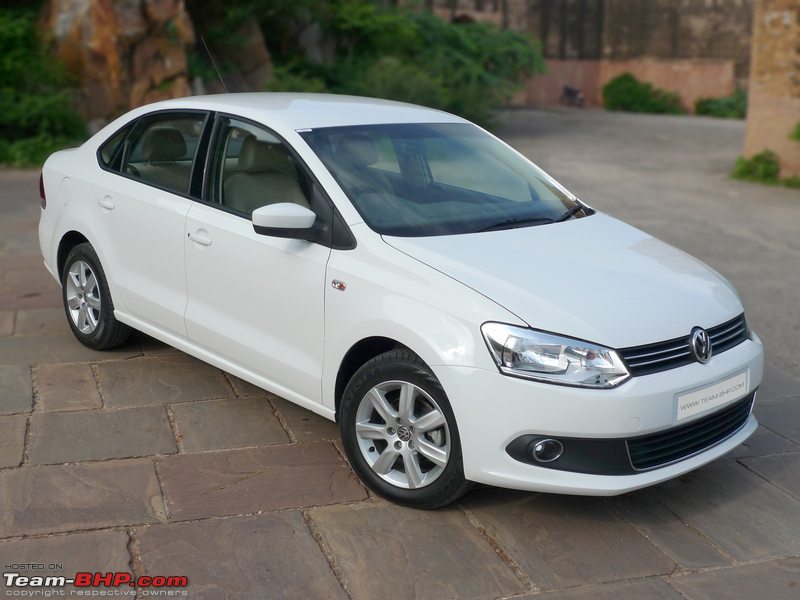
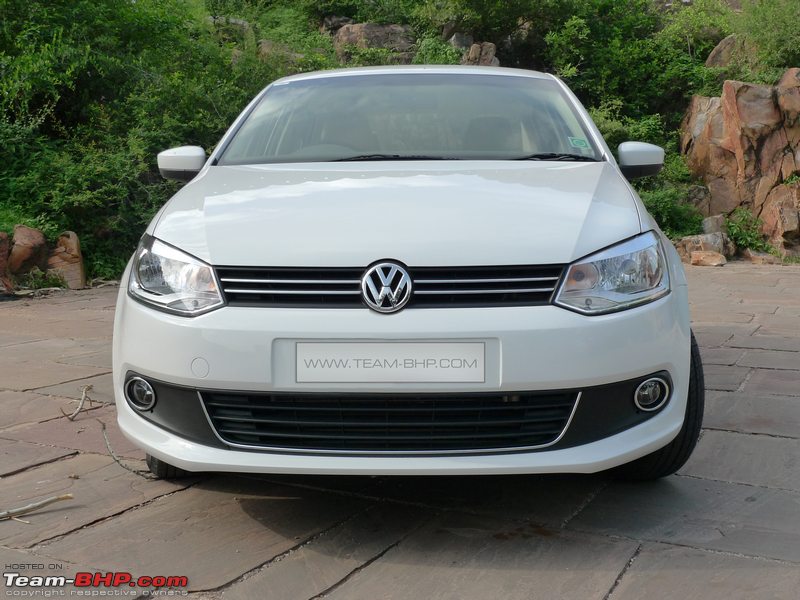
The Polo's launch was a mixed bag. While the general consensus is that the hatchback is high quality, and has excellent ride & handling, the 3 cylinder engines (diesel especially) are the only flies in the ointment
Link to full review). No such issues with the Vento. An 8 lakh rupee car allows the manufacturer considerably more flexibility in cost than one that retails at 5 lakh rupees. VW wants an Indian market share of 8 – 10% by 2014 – 2016; its cars like the Vento that will help the brand achieve those numbers.
Structurally, the Vento is a Polo with a boot, just like the Punto / Linea, Jazz / City, Swift / Dzire and Vista / Manza. From the pictures, one can tell that the boot is exceedingly well integrated. In person, the merger looks impeccable. In fact, the Vento looks as if it was designed from a clean sheet of paper. I loved the Polo’s styling and things are no different with the Vento. This VW sedan carries forward the same understated design, no Hyundai Verna-like quirkiness here. It’s a neutral look that will offend none. The front is identical to the Polo, save for the redesigned air-dam and fog lamps. A longer wheelbase is immediately apparent when viewed from the side, while you can see some of Ford’s design philosophy at the rear. I am a fan of the low, wide stance and personally think that the Vento is best in white. That said, the external styling is rather conservative in a traditionally VW way and won't be turning any heads. The Vento certainly doesn’t carry the “wow” factor of the Linea. Panel gaps are consistent throughout, the paint job exudes quality and the build overall feels solid.
Take a look at the statistics below. The Vento occupies a near identically sized footprint as the segment leader, the Honda City. The difference in width, height and wheelbase is 4 mm, 14 mm and 2 mm respectively. Kerb weight for the petrol Vento is 1,120 kilos, exactly a 100 over the Polo and a mere 20 kilos over the Honda City. The diesel Vento weighs 17 kilos more than the Verna, and a whopping 101 kilos lesser than the Linea.

After the fierce battle amongst the B segment hatchbacks, it's time for a war in the C segment. Volkswagen has priced the Vento right between the SX4 / Verna / Linea brigade and the Honda City. The City is what VW is aiming squarely for…after all, the Honda finds about 4,000 new homes each month and is the undisputed leader. The price gap between the SX4 / Verna / Linea and the Honda City existed for years; it was only a matter of time before someone jumped in between. VW's pricing strategy is such that SX4 as well as City potential owners can, both, realistically consider the Vento. Ironically, the cheaper Polo has a premium positioning (amongst hatchbacks), yet the Vento is a regular priced C segment sedan.
I wouldn’t be surprised if the Vento matches the Polo’s sales figures. Or even beats them. An important point to note is that the SX4 & Linea retain their VFM positioning. As they say, God bless competition!
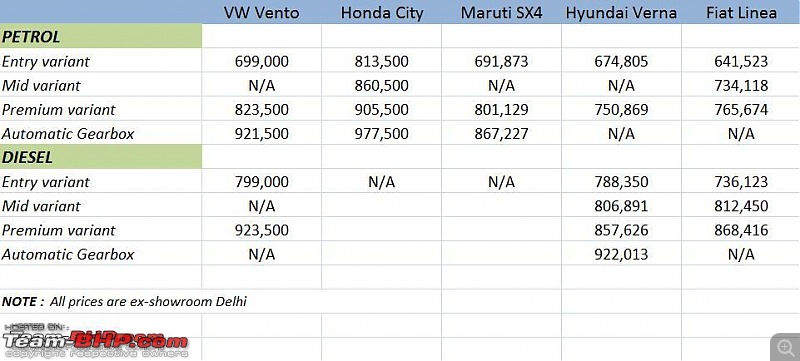
The Polo is offered in 3 trim levels, while the Vento inexplicably only has two. The Comfortline (between Trendline & Highline) is missing & may follow later. VW better get it quick as the middle variants are the ones that offer the highest value. The difference between the Polo and the Vento, variant to variant, is 2.5 lakh rupees. What you get for that money : one more engine cylinder, more power & torque, a longer wheelbase (96 mm), wider track, increased length (boot included), climate control and some other oddities. Between the Trendline & Highline Ventos, the difference is about Rs. 1.25 lakhs. For that money, you get ABS, dual airbags, alloy wheels, climate control, keyless entry, security system, rear power windows, electric mirrors, height-adjustable driver's seat, MP3 / CD audio system, a multi-function display, fog lights, rear armrest and some miscellaneous bits. Fact is, the Trendline variant is simply too basic with its sparse equipment level. If you go the Vento way, I'd only recommend the Highline.
Seamlessly integrated boot:
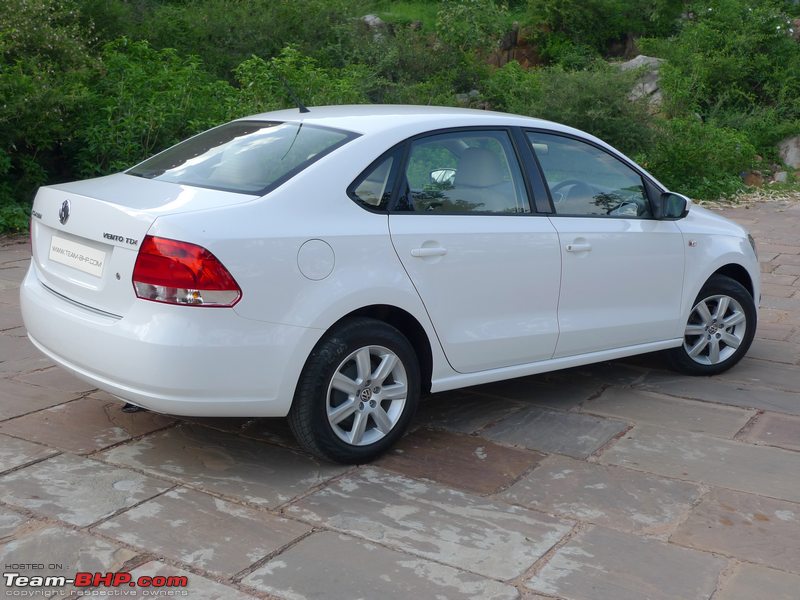
Extended wheelbase over the Polo is obvious. Notice the cable carelessly dangling below. Raised for India suspension, ground clearance of 168 mm:
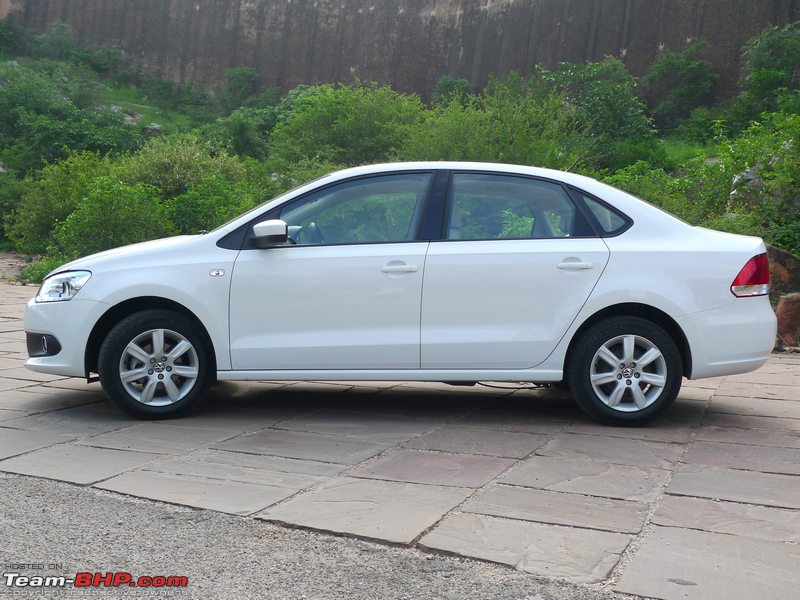
Tail pipe is hidden from rear view. It's neatly tucked under the bumper:
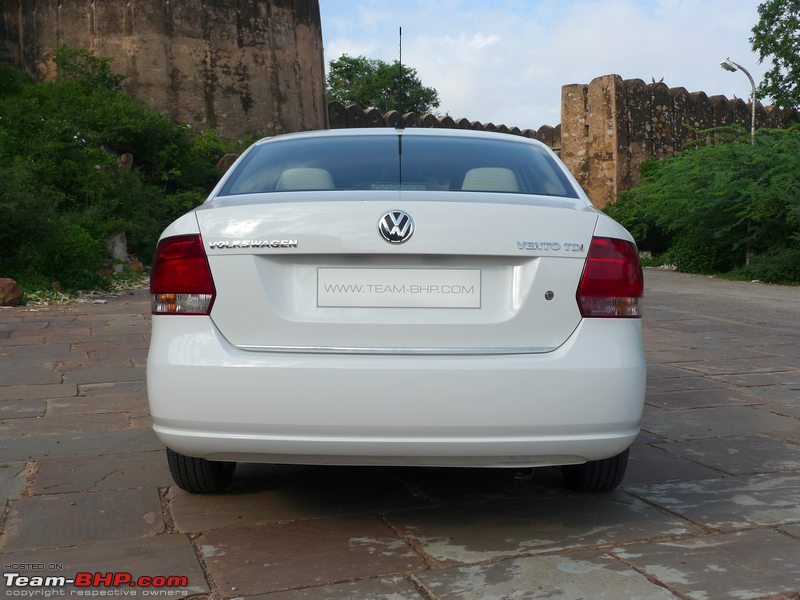
Polo front, save for the fog lamps and lower air-dam design:
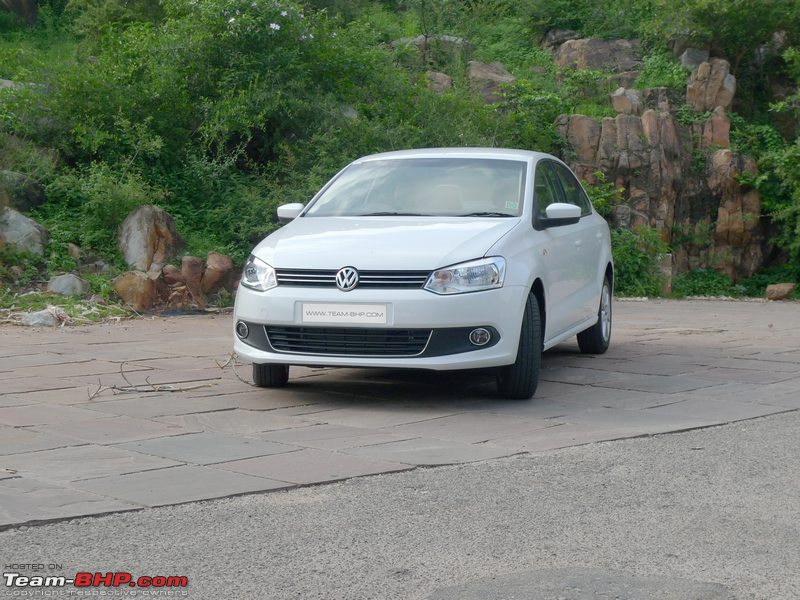
Polo headlamps. Wish we got the twin-focal smoked European units pictured
at this link:
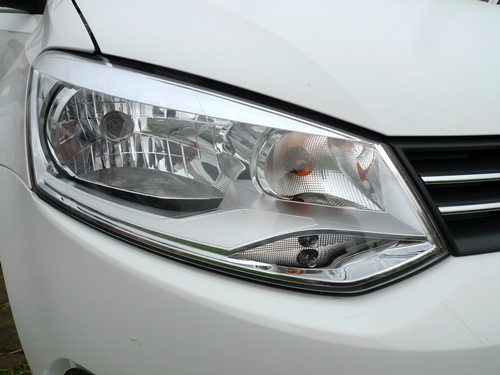
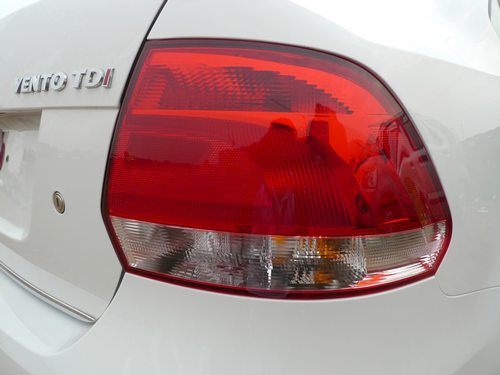
Chunky 7 spoke alloy wheels. Amongst the better OEM designs. 185/60 R15 rubber on the Highline variant:
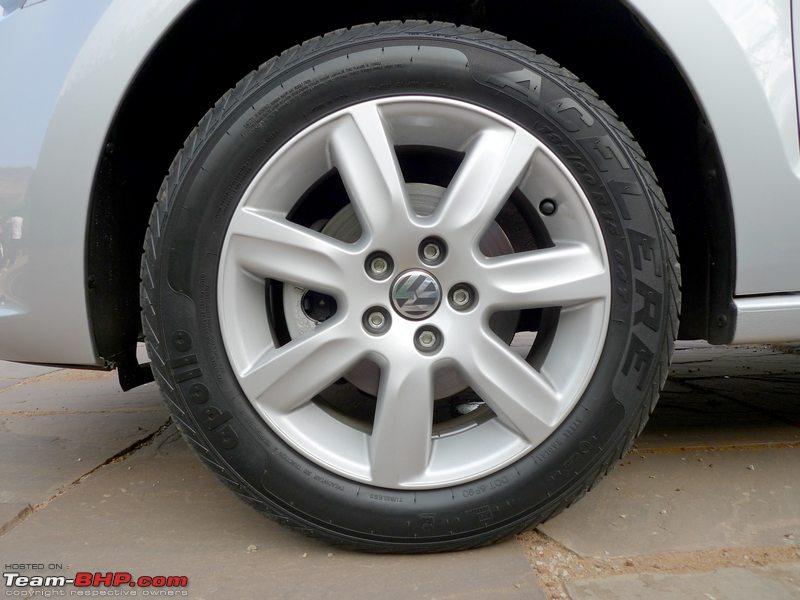
So uncool! The rear tow hook sticks out like a sore thumb:
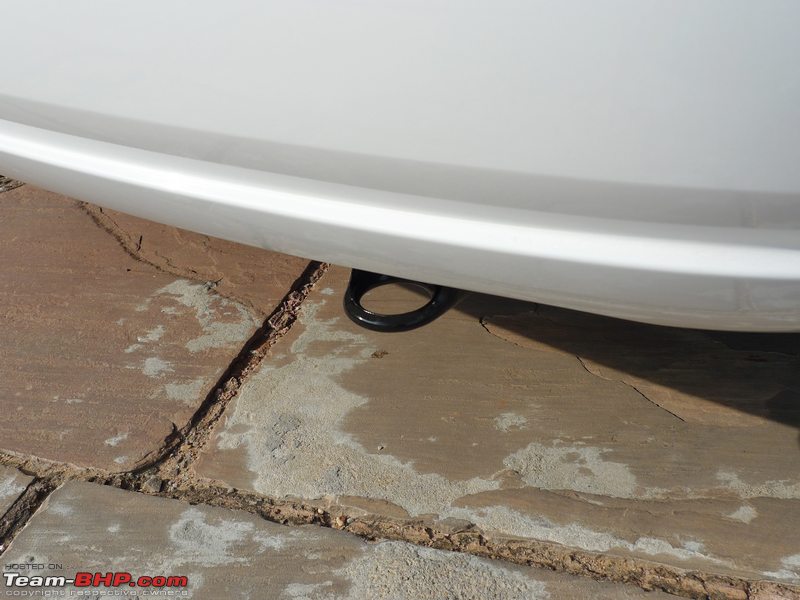
The suspension's bottom spring mount plate seems to be placed too low. It moves with the wheel though, and wont hit anywhere. This type of a setup is rare:
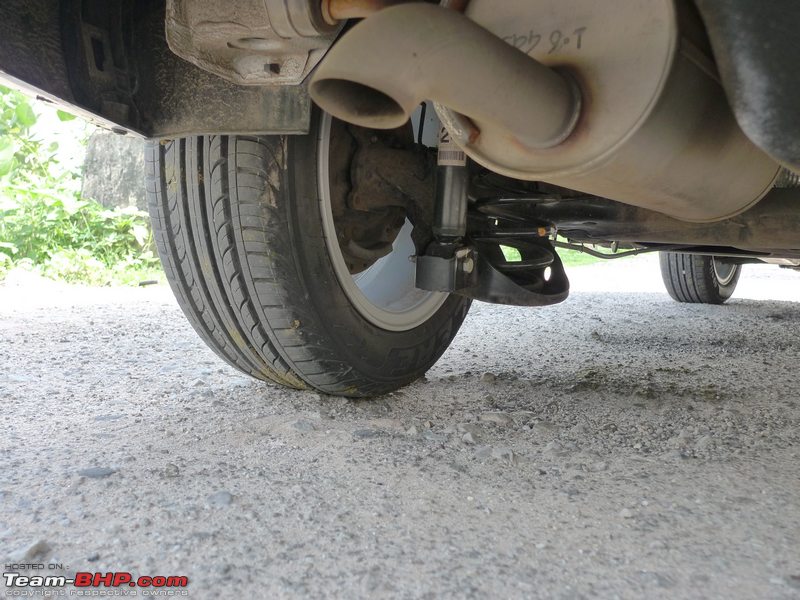
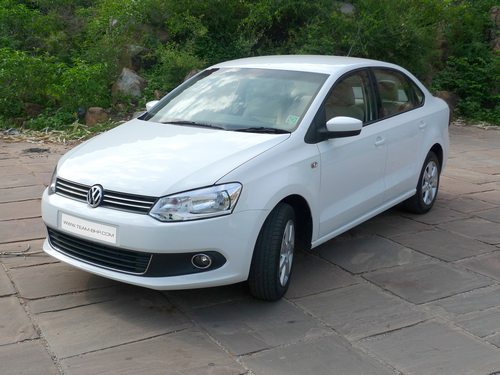
A look at a silver Vento:
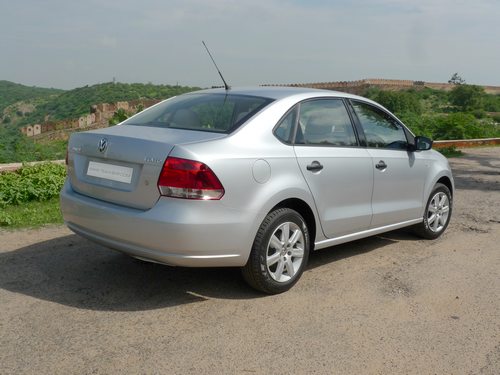
Full brand name on the boot. Unusual for VW, they don't normally do this. Early Polos only wore the VW badge. Some marketing research firm must have told them its better for brand visibility:
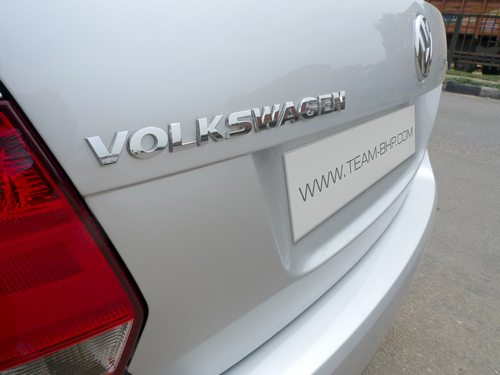

The heavy doors open / close in a three-stage action, and there's a mild thud when they are shut. The Vento is low slung, shorter than even the Honda City, hence ingress / egress aren't as easy as in the tall Maruti SX4. You have to "sit down" inside. The elderly and those with bad backs, please make note. The interiors are straight forward in a typically German way. There are no swoopy curves or any "wow" factor; rather, the focus is entirely on function. The Vento gets an interior colour combination of “brey” (some brownish grey, term inspired by Toyota's
greige :)) and beige, with some chrome accents thrown in. I didn’t like the brey the first time that I saw it, but got used to it over the course of the day. I personally prefer the Polo’s classy jet black & beige combination. However, the Vento’s brey will pass off as black to the casual observer and is certainly not as cheesy as the i20’s brown interior shade. Goes without saying, anyone who has driven a Polo will feel immediately at home. Most interior parts are common to the two. Fit & finish levels make for the segment best and panel gaps / part fitment are uniform throughout. All plastics are hard to the touch though (no soft materials from the Fabia here) so don't expect any German premium'ness. The interiors are well screwed together and will easily handle abuse. As an example, there’s no way you could break the glove box lid, even if you tried! I must add, the choice of seat fabric is extremely tasteful. The seat compound is neither too soft nor too firm, it’s just right.
The beige interiors and generous glass area allow a significant amount of light in, making the cabin feel airy. The front seats are narrower than you'd expect; they are certainly not small, but not super wide either. I look forward to comments from heftier BHPians on how they found the comfort levels. The back support is A+ and the entire spine is well taken care of. There's generous room up at the front, including leg / knee / foot room. The long travel front seats ensure that 6 footers won't have any trouble fitting in either. On the front passenger seat, I could completely stretch my legs (something even the Octavia didn’t allow). I particularly liked the adjustable (for height) center armrest that the driver can rest his left arm on. Tremendous utility over long drives, you can set it up at just the right height. On the flip side, the armrest severely interferes with the handbrake's operation. An ergonomic failure without a doubt. The steering tilt & reach adjustment have superb range. Some cars don’t allow the steering to go as low as I prefer, the Vento did. Just as in the Polo, the dashboard is positioned on the higher side. This can create a nuisance to short drivers in the Trendline variant (sans Driver height adjustable seat). In fact, I also ended up craning my neck from time to time. No such problems in the Highline variant though. The minute I cranked up the driver’s seat,
all izz well. Rearward visibility is poor, thanks to the useless (interior) rear view mirror, large rear headrests and the high boot lid. Thankfully, the external ORVMs do a good job of keeping you updated on the action behind. The three spoke steering wheel is wonderful to hold, as is the short gear lever too. In the Trendline variant, the horn pad extends to the steering rim. However, on the airbag-equipped Highline, you do need to stretch your thumbs to honk, as the horn pad doesn't extend as far out. The dashboard looks good overall, with the center panel tilting subtly toward the driver for that cockpit effect. All crucial controls are within an arm's length.
VW knew that a good number of C segment owners are chauffeur-driven, and have made clear their focus on rear bench comfort. A segment first is the ability for rear passengers to adjust the front passenger seat (fore & aft). There are rear air-conditioner vents (Linea is the only other to offer the same) with independent direction control for two passengers. Improved knee room from the extended wheelbase is apparent the minute you step inside. Space is adequate for even tall rear benchers, and available legroom is reasonable. It's only "sufficient" though, and surely not "excellent". The City does nudge ahead in interior space, but the difference isn’t enough to make or break a deal. There’s a tremendous amount of glass area at the back making for a bright, airy ambience. The rear headrests / neck restraints are perfectly positioned, and the large center armrest a good place to rest your arm on. No complaints on the headroom front either. The seat is a tad too upright for my tastes; a little more recline would have been welcome. The Vento is best as a 4 seater sedan. Reason? The flooring has a 5 - 6 inch high hump in the center. The (hopefully occasional) 5th passenger will have to keep his feet on either side of the tunnel. And that in turn will interfere with the leg room of the other two rear passengers. As a consolation to the 5th passenger, he’s got the most cushiony seatback in the car. It's like a thick piece of soft foam! The air-conditioner does a good job and keeps the interiors cool. Plus, each of the 4 frontal vents has independent air volume adjustment, and can be completely shut too.
The Vento has first-class storage space. The glovebox is wide, tall and sufficiently deep. There are also cut-outs for your sunglasses, coins and loose business cards. A pair of innovatively placed bag hooks on the B pillars are cool. Door pockets on all 4 doors, while the front door bottle holders can hold 1.5L water bottles. The door pockets are medium sized and can easily carry the oddities. There are a couple of cubby holes around the handbrake area, and two well sized cup-holders right ahead of the gearshift.
Unfortunately, the Vento has the same (lousy) locking mechanism as the Polo. Firstly, the doors don't auto-lock when you start driving. To add to it, there isn't a visible lock / unlock knob sticking out of the door panels, reminding you to lock the doors. The only way to lock all doors is from the driver's control panel (passengers cannot lock their doors independently). So you'll have to be mindful of these facts and remember to lock the doors each time that you drive off. Then, if you open any of the doors, the rest of the doors still remain locked. I lost count of the number of times I opened the driver’s door, went to the back door only to discover that it’s still locked, and then had to walk back to the driver’s door to manually press the unlock button (to unlock all doors). We frequently drove around in an unlocked Vento with a laptop and two expensive cameras on the back seat, thanks to the lack of auto-locking & any visible "doors unlocked" warning sign. Again, a Maruti 800 with a 1,500 rupee central locking kit offers a more practical locking / unlocking solution.
Volkswagen sells the fully-loaded Highline variant with dual airbags, ABS, 15" alloy wheels, tilt & reach adjustable steering, height adjustable driver seat, all 4 power windows with one touch up / down action, electric mirrors, keyless entry with security alarm and immobiliser, rear seat center armrest, rear air-con vents, CD / MP3 audio system and an MID. Steering-mounted audio controls, AUX / USB stereo input, a dead pedal, folding rear seat and seatbelt warning buzzers (??!!! :Frustrati) are conspicuous by their absence. The audio system’s sound quality is strictly average. But a unit that isn’t USB / AUX compatible seems right out of the stone age!
Steering wheel is great to hold. Integrated audio controls sorely missed:

Simply the best gearshift this side of 10 lakh rupees. Short, slick and a joy to use:

Dials are very easy to read. When you start the car, the fuel gauge goes all the way up. When you switch off, it goes down in a nice progressive manner:

MID also easy on the eyes. Data provided = Instant & average fuel consumption, distance to empty, countdown to next service, external temperature, odometer and time:

Sound quality strictly average. Absence of AUX / USB support is shocking. Climate control is intuitive to use:

Even the indicator stalks exude a
built-to-last construction. Note the variable intermittent wiper setting and MID controls:

Foldable key shared with the premium VW / Skoda cars. Boot release button comes in handy. Windows can be rolled up by long pressing the lock button:

Adequate room in the footwell. Space on the left to rest your foot. Dead pedal missed:

Driver seat height adjustment has good range:

Adjustable (for height) center armrest rocks! Has a storage compartment inside:

All 4 power windows have one touch up / down function. Door locking solution is lousy. Notice electric ORVM adjustment knob at the top:

Rearward view is hampered by the high boot lid and large headrests:

Nifty bag hook on the B Pillar:

Sufficient legroom. In this picture, the driver seat has been positioned for a 6 footer:
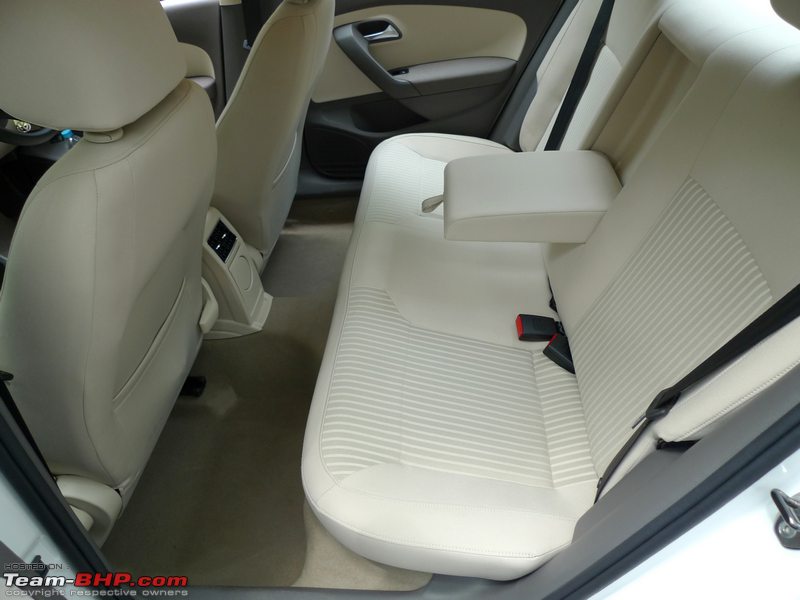
Prominent floor hump is an annoyance to the
hopefully-occasional 5th passenger. About 5 - 6 inches in height:
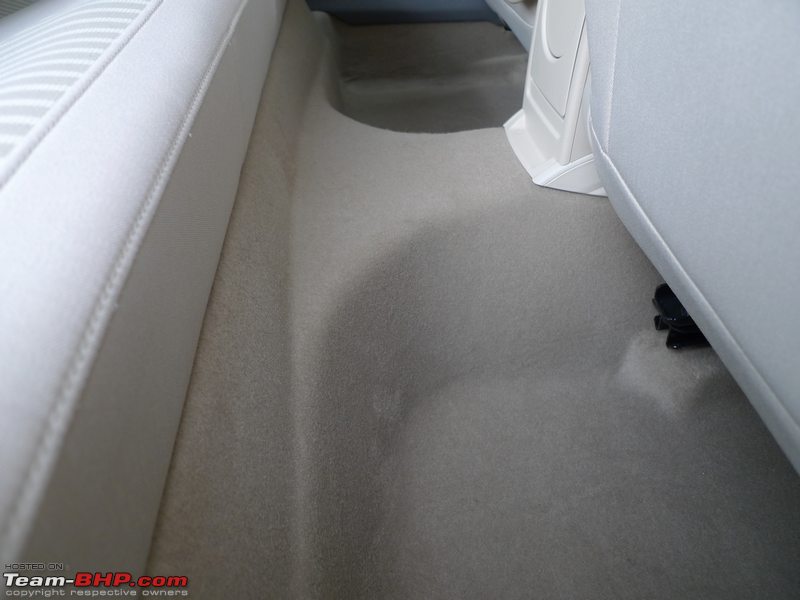
Rear air-con vents standard, even on the Trendline variant. Independent direction controls for either rear passenger:
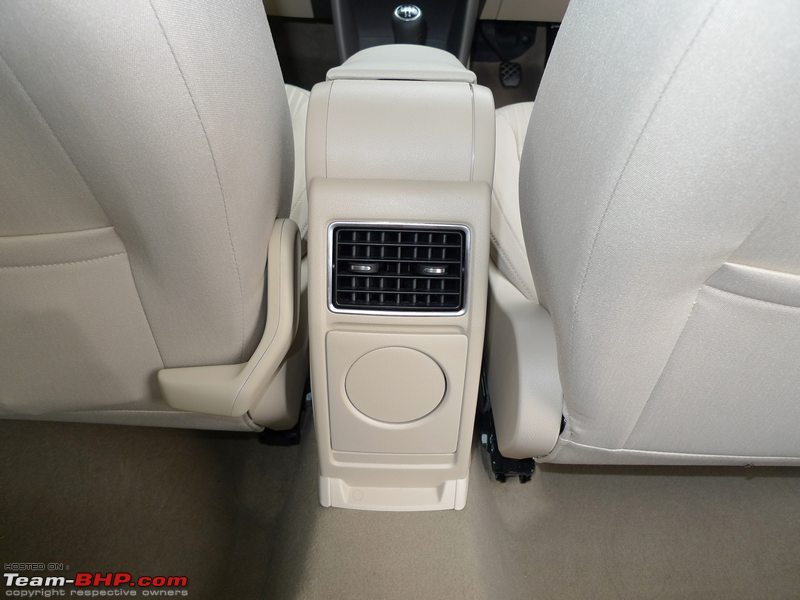
A segment first! Rear passenger can adjust the front seat (fore / aft) when he wants more legroom:
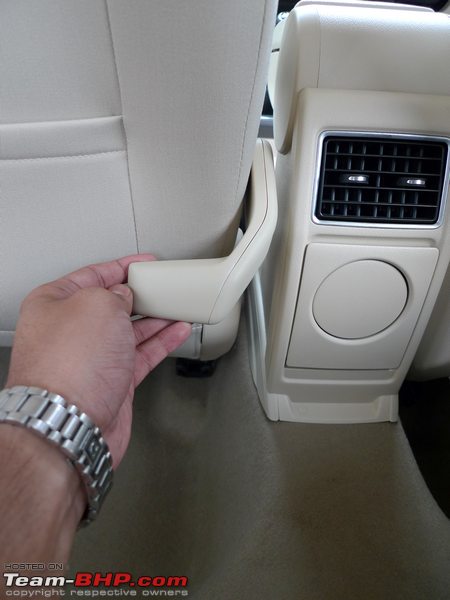
Rear quarterglass adds to the bright, airy ambience at the back:
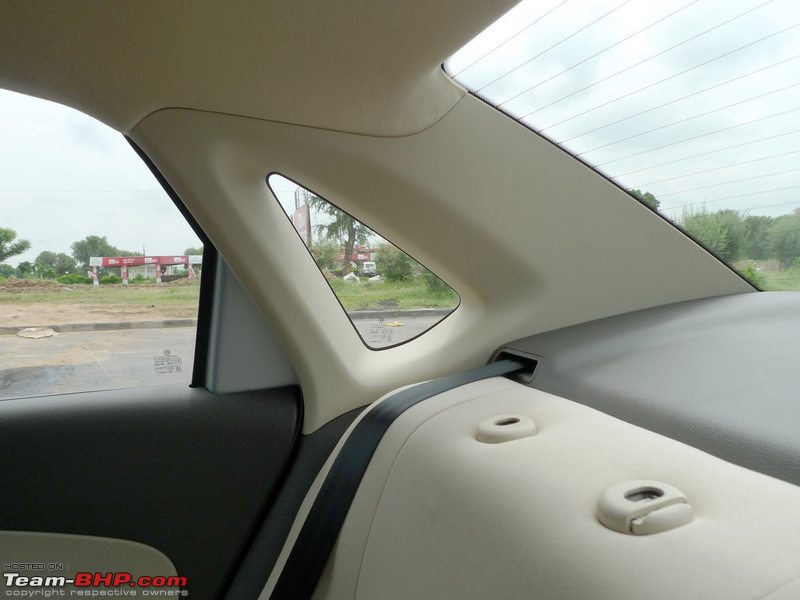
Deep 480 L boot. Wheel wells intrude noticeably. End to end carpeting. Fixed rear seat does NOT fold:
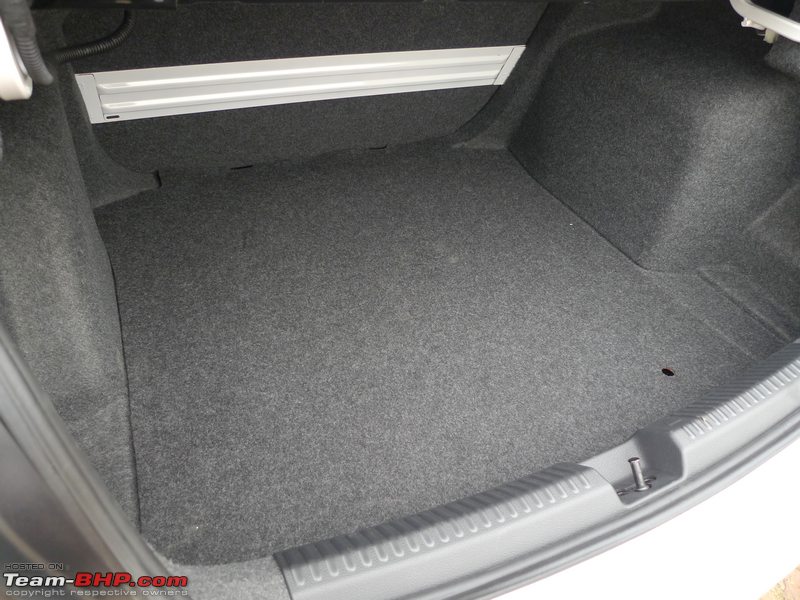
Unlike the 3 cylinders in the Polo that caused quite a stir, the Vento is powered by
proper 4 cylinder engines. I drove the petrol first, and was going to start this post with that engine, but the diesel completely blew me away. So...

Stats = 250 NM of torque at 1,500 – 2,500 rpm. Move over Hyundai Verna (235 Nm @ 1,900 - 2,750 rpm), the Vento TDI is the new torque king of the C segment. Not only does the diesel Vento make the most torque of all C segment sedans, it also equals its bigger brother, the Jetta (and its 2.0 L diesel). Get this, the Vento’s torque / weight ratio is superior to the Jetta as well as the Skoda Laura MT! The 1.6L unit is rated at 104 BHP (@ 4,400 rpm), 4 horses lesser than the Hyundai (108 BHP @ 4,000 rpm).
Start the engine and there is a certain amount of clatter. Once warmed up, things get better, though the diesel remains audible at all times. The 1.6 L under the Vento’s hood is a common-rail diesel, yet it sounds like the Laura’s 1.9 Pumpe Düse unit. At low rpms, marginal turbo lag is present, but it’s nowhere as bad as in the Polo. Fact is, the Vento is easy to live with in an urban driving environment. Driveability is decent and you certainly won't be using the gearbox as much. It's easy to close gaps in traffic without a downshift. The turbo has woken up at 1,800 rpm and the motor really gets onto its own after 2,000 rpm. There’s a sudden surge of torque and the acceleration, expectedly, is strong. The engine is also exceedingly revv-happy right upto 5,100 rpm. She strains after that, but if you insist, the engine will go on to 5,400 rpm. The Vento diesel's mid-range packs a mighty punch. Whilst cruising at a 100 kph in 5th gear, the rpm needle is hovering at about 2,100 rpm (turbo zone). If you want to overtake, merely press the accelerator to access
instant pep (no need to downshift at all). It’s a similar situation when you are cruising in 3rd gear at 50 kph (again, revv needle above 2,000 rpm). Floor the pedal and power delivery is instantaneous. In the petrol Vento, every overtaking manoeuvre requires a downshift. Not so in the diesel Vento; the strong mid-range is the new segment benchmark. The gearing is spot-on and VW has chosen the ratios perfectly well. Learn to keep the engine on the boil and you can really make fast progress out on the expressways. Also, high speed cruising ability is exemplary. Where the Linea starts running out of breath at 130 kph, the Vento is eager to accelerate, even at 140 – 150. This car easily seems capable of hitting a top whack of 186 kph, and an indicated 200 kph (as someone else found out :)). No way is the power delivery linear though. There is a sudden surge after 2,000 rpms. Don’t make your passengers uncomfortable by frequently pushing them in the back :D. The highest torque rating and relatively lighter kerb weight of the Vento undoubtedly play a part in its stunning performance. The short-throw gearshift is slick, albeit the one on the petrol is the segment best. Shifting in the diesel Vento definitely required more effort than in its petrol sibling. A unique feature about the Diesel Highline is the MID’s gearshift indicator. If you are in too high a gear at too low a speed, or vice versa, the gearshift indicator will suggest what gear you should shift to, along with an up / down arrow (suggesting an upshift / downshift). Refer to the picture in the 6th post below. A negative point about the diesel is that you can feel excessive drivetrain movement on the pedals (clutch especially). Pedal vibration is on the higher side, only magnified by higher revvs. German turbo-diesels are usually fuel efficient and the Vento shouldn't disappoint on that front.

The DOHC 1.6 L petrol engine is rated at 104 BHP (@ 5,250 rpm) and 153 Nm of torque (@ 3,800 rpm). The Honda City 1.5 L petrol has 12 BHP more and 7 Nm of torque less. The petrol Vento also has the best torque / weight ratio of any petrol car in the C segment, though the difference isn’t as much as in the diesel. There isn’t immediate torque on tap when moving away from 0 kph, nor is there any action at low rpms. You need to generously use the accelerator & dial in some revvs. Throttle response at low rpms isn’t overtly sharp, its rather mediocre. Without doubt, the Fiesta 1.6’s throttle remains best in the segment. Be generous with accelerator input and the Vento petrol offers performance that is par for the segment. At low revvs, engine refinement is the diametric opposite of the Polo. Below 3,000 rpms, you can hardly hear anything on the inside. As long as you take things easy, which most people will within the city, the engines all but inaudible. Work up the revvs, and the engine takes a throaty note above 3,500 rpm. Some will like it, some wont. It’s fairly audible at high rpms, yet doesn’t sound coarse or rough (as say, the Polo did). Refinement is acceptable even at 5,000 rpms (no unnecessary roughness) and vibrations are well controlled. I had a lot of fun using the 3,000 – 6,000 rpm range, the engine portraying a fairly revv happy nature. The dial-indicated redline starts at 6,000 rpm while the revv-limit is 6,300. It’s easy to enjoy a spirited drive on the highway, even 150 kph is attained without a fuss. On the other hand, unlike the diesel Vento, every overtaking manouveur requires a downshift. Some gear ratios are on the taller side (VW’s attempt to maximize fuel economy). The City remains the sprinting champion of the segment and is overall more refined too. The petrol engine when viewed independently is competitive. Bring in the diesel though, and it's completely overshadowed by her oil-burning sibling. Working the 5 speed gearbox is bliss! The petrol Vento (and Polo) easily has the best gearbox this side of 10 lakh rupees. An optional 6-speed automatic transmission is available. Refer to
post no.7 below to know more.
Even your grandmother could change the oil now. Convenient placement for the oil filter:

Look at all that space in the engine bay. Should be easy to work on:

The front suspension has a ubiquitous McPherson strut layout, while the rear is a semi-independent trailing arm. The Vento has a distinctly firm edge to itself at low speeds. It's not uncomfortable, but the stiffness becomes obvious when you go over sharp bumps or broken rural type of roads below 40 kph. Ride when puttering about in the city is at best “compliant” and NOT “plush” (like the soft Manza, for instance). As the speedometer climbs, the Vento can flatten the worst of Indian roads. The heavy-duty suspension feels robust, the car obviously has tough underpinnings. You don't need to slow down for rough patches either, the bump absorption is satisfactory, and passenger comfort of tall order. Importantly, there is no unnecessary vertical movement or bouncing over a 100 kph. This planted nature goes a long way in enhancing comfort levels. VW recommends a rear tyre pressure of 38 PSI when fully loaded. I found this to be on the higher side, and lowering a couple of PSIs noticeably enhanced ride comfort. The Vento retains the Polo's handling capabilities. It loves long straights and corners alike. The sedan stays superbly composed even when hurtling through a series of fast corners. The chassis has immaculate poise and grip levels are strong. Body roll is well controlled too. Pushing hard will see her slowly understeer in an entirely predictable manner (no nasty surprises). Stability at speed is top class, second only to the Linea, and there isn't a hint of nervousness at 140 kph. The Fiat is rock solid (remains the segment benchmark), the Vento solid
enough. On the other hand, the electric power steering spoils the enthusiast' recipe. It’s super light at 0 kph parking speeds, and stays light all through city speeds. This not only makes piloting the Vento effortless in congested cities (turning radius = 5.4 meters), but also makes her feel very manoeuvrable in tight traffic. Its easy to chuck the Vento in and out of gaps. Problem is, when cruising at a 130 kph, I found the steering lighter than I’d have wished for. The PS is fairly accurate, but don't expect any feedback. You’ll never know what the front tyres are up to. Also, one can feel some artificial centering action. If only the Vento was equipped with a proper hydraulic steering unit.
Tyre noise is surprisingly well controlled at speed. Some amount of wind noise is evident from the A-Pillar / ORVM area, but it's too little to create a bother. On the other hand, rear passengers can hear the suspension doing its work. Its fairly audible over rough roads. The brakes are terrific and deserve an A+ rating. The pedal is easy to modulate and the overall braking action is extremely confidence inspiring. This, with the Apollo Aceleres running as stock tyres! It’s easy to control just the amount of braking you want, whether in bumper to bumper traffic or when shedding speed and entering into a tight corner. The ground clearance of 168 mm does the job.
For several years, the Honda City remained the only all-rounder from the C segment. It has 14 years of hard earned goodwill under its belt, and a proven track record of hassle-free ownership. Well, the City has a fierce competitor in the Vento now. The VW is equally an all-rounder and has no real deal breaking disadvantage. Plus, there's a stunning diesel engine on offer. After-sales quality is a crucial area that Volkswagen needs to prove itself on. End of the day, competition only makes things better for us, the customers. VW couldn't do it with the Polo, but the Vento hits the
sweet spot.
Other Points:
• Trivia : The “Vento” badge was actually used for the 3rd generation Jetta in Europe (1992).
• Vento deliveries commence on the 6th of September, 2010. Current localisation level is 60%.
• Why isn't there an AT option on the diesel? Me thinks, its VWs way of avoiding an overlap with the Jetta. Either ways, a missed opportunity. Diesel + AT holds huge potential in urban markets. Premium customers are increasingly showing their preference for automatic oil burners (just ask your sibling, Skoda).
• The Polo still has a long waiting period. If VW can manage supplies (read, no bottlenecks), the Vento will rush up the sales charts. Though there will inevitably be some backlog over the early weeks, a second shift has begun at the Chakan plant for the Vento.
• Expect mega-bucks to be spent in advertising. Few car manufacturers can match VW’s fiscal strength. Remember the
VW of India newspaper edition? We actually got a brief preview of the Vento TV commercial. The video shows how workers at the VW factory build the Vento with (supposed) care and emotion. The initial frame has a lady worker caressing the bonnet, with tears et al. Then, there's a shot of someone running after a sub-assembly as its being transported around the factory. When a completed Vento is being driven away, an engineer runs behind it screaming “Please take care of it, will you”.
• Volkswagen has a mere 47 dealers in India. They can't hold a candle to the distribution strength of Maruti (over 800 dealers) or even Honda's 120 outlets.
• Vento test mules were badged as Fords to misguide the aam junta!
Link to post.
• Service interval = 15,000 kms.
• Just like the Polo, the entry level variant is available in only two colours (White & Red). This is VW's way of restricting Trendline sales. It could potentially find favour amongst the hotel taxi segment too. Competitive entry level pricing, rear air-con vents, diesel economy, decent space and 15K kms service interval.
• Cool : Anti-pinch protection on all 4 windows.
• The Skoda Octavia replacement will be based on the Vento -
Link to thread.
• As you might have guessed by now, the petrol engine is par for the course, but the diesel is the undoubted pick of the two. This 1.6L diesel is the same engine being used in the Polo Cup Series :D (obviously retuned). How about a 130 BHP version for us enthusiasts?
Click here to read Mod Technocrat's PoloCup report.
• Note to VW : Please disregard our earlier requests for a Polo 1.6 Petrol. We now want a Polo 1.6 diesel.
• ARAI ratings : 20.54 (Diesel MT), 15.83 (Petrol MT) and 14.4 (Petrol AT).
• It's tough enough to operate the handbrake with the driver armrest in place. The problem worsens if there is a hefty passenger in the front seat. This is an ergonomic failure.
• Small touches that impress : The glovebox and rear cup-holder have rubber dampeners to prevent rattles.
• 14" wheels will look puny on the base variant. Vento needs 15" wheels at the minimum, if not 16".
• When you hit the redline, the needle doesn’t “bounce” off aggressively. The ECU smoothly halts any increase in revvs.
• Partially zinc coated body with 6 years anti-rust warranty for the Vento.
• While the air-conditioner does a great job, glass area at the back is massive. Over the hot afternoon highway drive, the blower needed to be cranked up to position “3”to keep rear benchers comfortable. Sunfilm is a "must-have" on the accessory list.
• Great sounding “Skoda Octavia” kinda horn.
• Expect a Polo-like maintenance package for 3 yrs / 45,000 kms. The Polo package costs about Rs. 19,000.
• The last diesel sedan I tested was
the Altis. By gawd, what a difference in engine response!
• Reverse gear has an unconventional placement. Up and ahead of 1st gear. You have to press the lever down to engage reverse. In a tight right-hander, if you are holding on to the gear lever for lateral support, you will unintentionally press it down.
• Control stalks have a left-hand-drive orientation (wiper on the right and indicators on the left).
• Lane change indicator : A mild push on the indicator stalk makes the turn indicator blink 3 times. Push fully to use the indicator stalk in a conventional manner.
• I'm expecting a good number of Vento diesels + power box + 16 inch wheels on the forum. Apparently, the power box takes torque to 300 NM! Will make for a heck of a machine.
•
Disclaimer : VW invited Team-BHP for the Vento test-drive. They covered all the expenses for this driving event.
The smaller yet significant things:
Not only is the spare a
non-alloy wheel, it's also a 14 inch size!! 175/70 R14 tyres. Obviously, overall diameter matches with the regular 15" tyres:

Pay close attention to the MID; it's telling me to downshift to 4th. I was cruising at 45 kph in 5th gear at this time. Gear change recommendations are accurate for the most part:

XL size glovebox. Well thought out partition on the floor, to hold the owner's manual:

Sunglass, coin and business card holders on the glovebox lid:

Another shot of the cockpit:

A vanity mirror, but no light for the lady. Driver side sunvisor merely gets a ticket holder:

Rear view mirror is hopeless! Small size doesn't offer a good range:

VW has a history of high PSI recommendations. The Passat's tyres were originally filled to 42 PSI! Corrected since:

Lots of room in here for knick knacks:

Single cup-holder for the
seth's coffee. Notice the small circular rubber dampers to prevent rattles:

Power window switch rebadged to serve as the boot release:

High quality compartments to hold the warning triangle, first aid kit and an extra set of headlamp bulbs + fuses:

4 pieces of medium sized luggage and two laptop bags are an easy fit:

Typically European headlamp controls:

Vanilla-plain Trendline front:

Vanilla-plain Trendline dashboard:

In the Trendline, only front power windows can be controlled by the driver:

Gotta appreciate an eye for detail.
All of our support vehicles were VWs, including the mini bus:
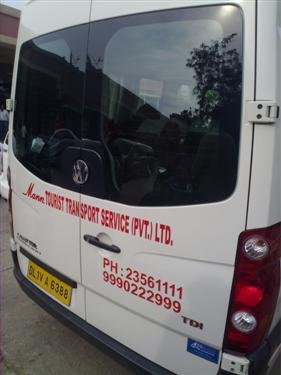
The Automatic Transmission Vento. Currently available in petrol only.
The following Vento AT review has been compiled by Rehaan. 
The Vento AT has a 6-speed automatic transmission mated to the 1.6 petrol engine. In D mode, up-shifts are very smooth and jerk-free, almost unnoticeable except for a change in engine note. The transmission tends to shift up fairly early, as it has probably been tuned to maximize fuel efficiency. Seeing an indicated 5th gear at about 50 kph is not an uncommon sight. This behaviour makes it a fairly common occurrence for the Vento AT to down-shift one gear (or even two) under mild acceleration. This can get a little frustrating with the slush-box when you want instant go, as the Vento AT is underwhelming in these situations. It really won't get anywhere too fast. Further, the AT & the engine seem a tad strained when made to work hard (pedal to the metal), and can get audible on the inside. However, if you just want to potter around town or slide along with rush hour traffic, the performance of the AT is par for the course, and has a clear convenience advantage over the manual transmission.
“S” mode allows for more spirited driving where the transmission will pull all the way to the redline in each gear. It will, however, up-shift on its own at the redline to preserve the engine & transmission. The same applies for down-shifting when it feels that the RPMs are dropping too low.
Lastly, there is a “manual shift” mode, similar to tiptronic shifting. Move the gear lever to the left while in D position, push forward on the lever to up-shift, and pull backwards to down-shift. Gear changes are fairly quick in this mode, though the Honda City's AT is quicker, and the DSGs are in a different league altogether. Nonetheless, if you want a slightly more involving drive in an AT Vento, this is the mode to use. It holds the gear you specify even when you’re accelerating with a very light foot, and only up-shifts on the redline. If you're one of the more aggressive drivers in traffic, holding 2nd gear in this mode works very well (much preferred to staying in D). With a gentle dab of the throttle, she’ll even start in 2nd without a fuss (1st is a fairly low ratio, geared more towards hill-starts and the like).
To sum up the AT option; if you like giving your car some stick on empty roads, or late at night – this probably isn’t the choice for you. If you drive a lot within the city and at an easy pace, the convenience of leaving your left arm on the armrest and just chilling during the drive can't be matched by the manual transmission version.
The MID has a gear indicator on the top right corner. It also indicates which mode you are in (eg. D1, D2, S1, S2, and 1, 2, 3 for manual):

Notations on the side of the gear lever are always lit, even during the day.
The indicator for the selected drive mode lights up brighter when the lever is in that position:

Press the button on the front of the lever to move it out of Park, or between "R" and "D":

You have to rest your left foot on the carpeted floor, as there isn't any dead pedal provided (a rare automatic car to not offer one):
 Additional Points
Additional Points
• Since there is always a slight torque on the brakes due to the AT transmission – you’re much more likely to hear a vibration like moaning sound from the brakes just as you begin to let go of the brake-pedal.
• You really have to pull the handbrake up high, as the automatic drive-train tends to overpower the handbrake unless pulled very firmly.
• Slightly plasticy shift quality of the gear lever itself. Fairly firm to shift.
• A fair deal of vibration can be felt in the cabin at idle, and especially through the brake pedal.
Chief Competitors of the VW Vento
Honda City: 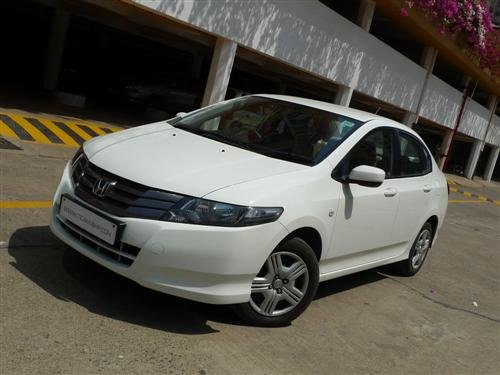
Owners liked:
- Modern styling and design
- Outright engine performance
- Spacious well-designed interiors
- Excellent ride quality
- Honda reliability & durability
Owners disliked:
- Cheap interior part quality
- Sparse equipment list
- Lacks the quality of outgoing generation
- Below average customer support
Maruti SX4: 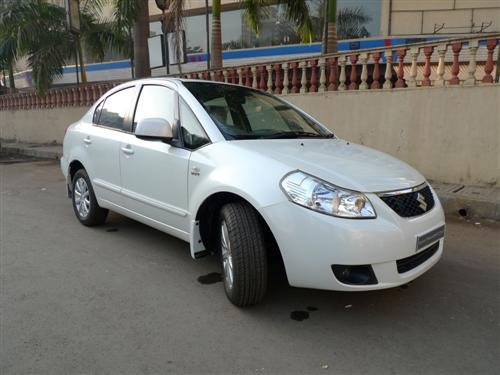
Owners liked:
- Value-driven pricing
- Solid build quality
- Quick petrol engine
- Safety features on offer
- Spacious and well-spec'ed interiors
- Fantastic Maruti service
Owners disliked:
- Stiff ride quality at low speeds
- Lack of overall quality
- Sub-par fit and finish for the price
- Low engine refinement levels
- Rear seat center-hump
Hyundai Verna: 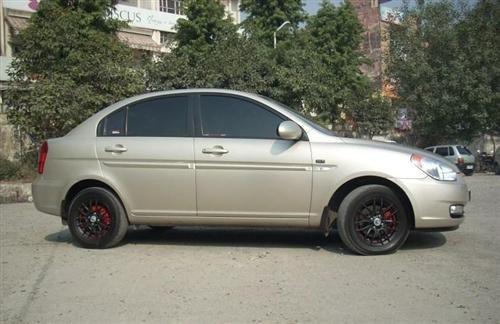
Owners liked:
- Outstanding diesel engine
- Spacious and comfortable interiors
- Absorbent ride quality at low speed
- Splendid service backup
Owners disliked:
- Lack of character and road presence
- Bland interiors
- Underwhelming petrol engine
- Boat-like ride & handling at high speed
Fiat Linea: 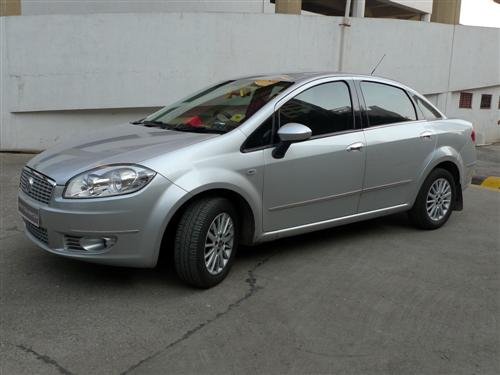
Owners liked:
- Elegant styling
- Solid build quality
- Fuel-efficient diesel
- Brilliant handling & dynamics
- Mature ride quality
- Top level of equipment
Owners disliked:
- Compact rear seat confines
- Lack of outright performance (either engine)
- Interior fit, finish and quality are below average
- Shoddy after-sales support
- Niggling issues
NOTE : Competitor information sourced from the
Team-BHP Ownership Review Section. Special Thanks to BHPian
ZeRo© for the suggestion.
Wow! very good stuff.
This one will boost VW sales for sure.
As usual, very good report and comparison GTO.
Rear air-con vents, one thing I am missing in my CEDIA
Great review GTO.Your hardwork has paid off.clap:
I thank you for this extensive review and excellent pictures.Honda should be worried for sure.I will have to forward this review to many friends (non Bhpians) who were eagerly awaiting your review .It seems our NHC will be replaced by the diesel Vento.
excellent review GTO.
Now Time for VW to satisfy some torque Hungry wannabe polo owners lol?
I Kinda Noticed the Other Day , The Dzire has almost the same front grill as the vento !
Like the Altis VW should have created differentiators between the Hatch and the Sedan.
Say a Mesh Grill maybe? Or a skoda Style vertical Grill.
Quote:
Originally Posted by GTO • Note to VW : Please disregard our earlier requests for a Polo 1.6 Petrol. We now want a Polo 1.6 diesel.
|
+1
We'll make ourselves a nice polo cup car for the road. :D
Quote:
Originally Posted by GTO • Partially zinc coated body with 6 years anti-rust warranty for the Vento.
|
:thumbs up
Thank you for the review. With each and every report, the quality of the reviews have gone up a notch, and with this one, you've set a very high standard. I don't think any automobile magazine in India can report in the same way, makes me really proud.
Back to the car, I have a few questions:
a. Both the cars have nice and wide footwells (nice pictures by the way), what's stopping VW from providing a dead pedal? You brought it up in the review, did you get to ask them this question? To me it's a lack of attention to detail, it's all very fine to have rubber bits to stop rattles, but what about driving comfort.
b. For me, this looks too much like the Polo. Do you think it can affect sales negatively? Especially since the Polo in Highline trim (in diesel) is almost the same price as the Vento petrol. I know that in India, a 3-box sedan is seen as a different breed, but still.
c. Why is the 'hump' in the middle of the rear seat so high? Is it the same in the Polo?
Once again, thanks for the review and the fantastic pictures too.
Brilliant review as always. Also VW dosent seem to be selling any DSGs in India right now. I think they are waiting for the new generation ones to come out globally.
I think the Highline diesel will sell really well and take a chunk of the Citys market share.
Excellent reviews GTO. Loved reading them. :thumbs up
Lack of features including dead pedal, aux and USB is unacceptable. Rest, I have just loved the overall offerings on the vento (esp. engine) at a good price. Leather seats on Highline could have been an added bonus though..or am I asking for too much?:D
I would take the opportunity to appreciate VW's efforts to invite team bhp for test drive, they are doing what ever they can for the positive publicity of their car and moreso their brand.
Lastly, I would also appreciate your efforts to bring us quality test drive report of the much awaited Vento. The newly added section of positives and negatives of competition is another value addition. Thanks.
| All times are GMT +5.5. The time now is 07:57. | |




































































